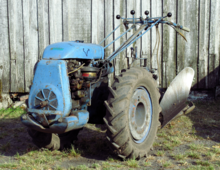Two-wheel tractor
A two-wheel tractor , also Einachstraktor , behind tractor or tiller rider called, is an agricultural machine for soil and grassland processing as well as for transport tasks or land and roads maintenance.
A two- wheel tractor has only two wheels driven by a petrol or diesel engine by means of a mechanical gearbox or also hydrostatically and is steered by the operator who usually follows the machine. Differentials and individual wheel clutches and / or brakes can be installed to make steering the tractor easier. Single-axle tractors regularly have one or more PTO shaft (s) . It is often possible to turn the handlebar 180 degrees in order to be able to operate certain attachments such as bar mowers in the front. Common attachments are milling or Umkehrfräse , plow , mower , mowers , Bandrechen, sweeper , snow blower , syringes , pumps, and single-axle trailer , partly with drive axle (by way PTO driven trailer axle).
Single-axle tractors were very common in the 1950s to 1970s. In addition to being used in gardening and landscaping, which is still common today, they were also often used in small farms, especially as a sideline. With the single-axle tractor, however, it was only possible to continue to use some of the already existing devices for draft animals , but as a rule - for plows, for example - an attachment adapted to the respective tractor was required.
Today, the two-wheel tractor is still used in gardening shops , in gardening and landscaping (especially as a bar mower for cutting tall grass), in communal services and by part-time or hobby farmers because of its wide range of uses. Advantages over the use of a four-wheeled small tractor are above all the great maneuverability and the soil protection given by the comparatively low weight. The size and yield of the area to be processed are often decisive, which determine the price-performance ratio of the motorized machine to be used. Smaller single-axle machines are also useful for hobby gardeners who cultivate large gardens and can do many different jobs with the tractor.
In regions with a rather low level of development, the single-axle machines are still used quite often in agriculture, as in these areas the advantages of lower acquisition costs (purchase first of the tractor with plow, later the transport cart, etc.), the multifunctionality and the maneuverability are often higher Are relevant. For example, due to the narrow width of this type of tractor, it is also possible to drive on former mule tracks away from paved roads.
Manufacturers of single-axle vehicles in the German-speaking area were or are still partially: Agria , Aebi , Bucher , Bungartz , Fahr , progress , Gutbrod , Hako , Holder , Honda , Husqvarna , IRUS , Köppl , Monax, Rapid , Reform , Schanzlin , Schmiedag , Siemens-Schuckertwerke , SOLO
Single axle race
In recent years, single-axle races on cross-country tracks have enjoyed increasing popularity, especially in Switzerland. Starting with a traditional single-axle vehicle with a trailer (which is, to be precise, a two-axle vehicle), a large number of in-house designs are used, and different categories are started accordingly. The engines are mostly highly performance-enhanced and / or come from cars or motorcycles. The vehicles have front, rear or all-wheel drive, are equipped with seat shells, seat belts and roll bars and the engine is often - contrary to the original configuration - installed behind the driver. What all these vehicles have in common, however, is that the front wheels cannot be steered individually, but rather sit rigidly on an axle which the driver does not swivel by means of a steering wheel, but rather via handlebars that are moved sideways.
These single-axle races have also been held in Germany, in some places since the early 1980s. This spectacle takes place every spring in Spain, and is now sponsored by a well-known beverage manufacturer.
literature
- Wolfgang Wagner: The single-axle tractor book . Podzun, Brilon 2000, ISBN 3-86133-246-9
- Paul Schweigmann, Agricultural machinery and their maintenance . Publishing house Dr. Pfanneberg, Gießen 1955, reprinted by Bulldog Press, Limburg an der Lahn 1993, ISBN 3-9803332-1-3
Web links
Individual evidence
- ↑ Armin Bauer: Schlepper, The history of the development of a commercial vehicle . Kosmos, Stuttgart 2004, ISBN 3-440-09664-5 , p. 62




